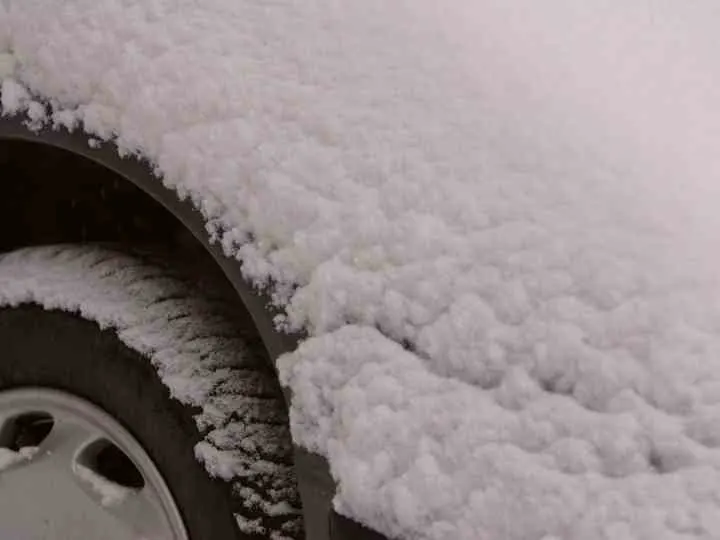As soon as you begin to see snowflakes in the air, you may think it’s time to dig your snow tires out of storage and get them on your vehicle.
However, that may not always be the case.
When should you put on snow or winter tires?
When you notice those flurries falling, this does not necessarily mean you need to get snow or winter tires on your vehicle!
Experts usually recommend that snow or winter tires should not be placed on vehicles until the outside temperature drops to at least 45 degrees Fahrenheit. These tires use a different rubber compound that will soften and wear out faster in warmer temperatures.
However, before you get your snow tires on your vehicle, make sure that a 45-degree temperature is not just a one-and-done event.
Rather, make sure those cold temperatures will be around day in and day out. Otherwise, you’ll have snow tires on your vehicle when they are not needed.
Should temperatures rise significantly, even to just above 50 degrees, you could be damaging your snow tires and also your vehicle.
When snow tires are used on pavement that is warm and dry, the tread wears out much faster than it does on snow-covered roads.
Also, since the rubber used to make snow tires consists of different chemicals and compounds than that used in regular tires, warmer temperatures usually result in snow tires becoming too soft.
When this occurs, your car won’t handle as well, making it harder to make sharp turns.

What Month Should You Put Snow Tires On?
Unfortunately, there is no one particular month when it is recommended everyone who needs snow tires place them on their vehicles.
Generally, it comes down to where you live and when you know the cold temperatures are going nowhere anytime soon.
In our experiences and when talking to tire-savvy folks, we have found the basic rule used most often is for you to have snow tires on your vehicle sometime between Thanksgiving and Easter, which would be between November and April.
In most areas that do experience cold temperatures for a long duration between these months, it’s almost always likely that temperatures will begin to drop to 45 degrees Fahrenheit or lower during this time.
Should you decide to wait until the first significant snowfall in your area before switching from all-season tires to snow tires, you may be making a mistake.
When the temperature starts to get colder outside, all-season tires tend to get more stiff, resulting in you needing longer braking distances.
Needless to say, taking longer to stop is not something you need to experience on snow or ice-covered roads.
Is It Bad To Put On Winter Tires Early?
If you jump the gun and put your winter tires on too early, it can be bad for your tires and your car in many ways.
For starters, subjecting your snow tires to warmer pavement will lead to them wearing out much faster.
Thus, when you actually need the extra traction they provide thanks to their unique tread design, you may have less of that at your disposal.
When this happens, your winter tires cannot grip the road as well as they otherwise would, increasing the chances you will be slipping and sliding.
Along with this, putting on your winter tires prematurely means you will be making more trips to the gas station to fill your fuel tank.
Due to snow tires having a higher rolling resistance thanks to their unique rubber composition, using them on warm, dry pavement means your car’s fuel efficiency will be lowered.
Of course, if you wear out your winter tires by putting them on too early, you’ll also be spending more money to buy new snow tires more often than you expected.
For most snow tires, a new set that is used properly should last for as long as four or five years.
However, if you leave your snow tires on year-round or install them before outside temperatures remain below 45 degrees Fahrenheit, you’ll wear out their tread and find yourself spending hundreds of dollars annually on a new set of winter tires.
Is It Too Early to Put on Snow Tires?

When you are asking yourself this question, you probably already know the answer.
If you notice the temperatures are going up and down and are north of 45 degrees on a regular basis, then it is too early for your vehicle to have snow tires installed.
Unfortunately, many people make the mistake of installing their snow tires much too early.
Figuring it’s better to be safe than sorry, they tend to do so as soon as they see a few flurries falling from the sky.
While there’s nothing wrong with trying to be cautious and keep yourself safe while on the road, you also need to use your common sense and good judgment when deciding the best time to get your snow tires placed on your vehicle.
If you are unsure about this, you can always ask your local mechanic or head to a tire store.
Since these folks know all there is to know about cars and tires, they can give you the advice you can trust.
Ultimately, it’s your decision! But when you consider the pros and cons of having snow tires on your vehicle, you’ll find it’s best to let your common sense guide your thinking.
Does My 4WD Vehicle Need Snow or Winter Tires?
When many people buy a 4WD vehicle, we find they think all of their winter driving problems are solved. However, we know better.
When you are driving a vehicle with 4WD capability, you will have a vehicle that gives you more control in snow and ice. However, the 4WD feature does nothing to help your vehicle stop quicker or necessarily prevent slipping and sliding.
To have more control over stopping or sliding, any 4WD vehicle needs to be equipped with snow tires.
Once your vehicle has winter tires, the combination of these tires and 4WD capability will definitely make it much easier for you to traverse even the slickest of roads.
Do Winter Tires Require More Tire Pressure?
Though many factors can come into play regarding the proper amount of tire pressure needed for your vehicle’s tires, we tend to find that winter tire pressure should actually be a bit higher.
When using your snow or winter tires, most car experts agree that winter tire pressure should be anywhere from three to five PSI higher than what the manufacturer recommends for driving under normal conditions.
When the weather where you live is warm, you can expect your all-season tires to lose about one pound of air per square inch each month.
However, tire pressure can fall more drastically in colder temperatures.
As temperatures dip, the air in your vehicle’s tires contracts, meaning you will lose one pound of air per square inch for every 10 degree drop in temperature.
Because of this, it is vital your snow tires have the proper amount of air in them at all times when you’re driving on snow and ice-covered roads.
Since tires that are too low on air are prone to wearing out quicker and not letting you handle your car as well on the road, you are making what are already unsafe driving conditions that much more dangerous.
By keeping all these tips in mind, you’ll get your winter tires installed at just the right time and ensure they last you for many years.
